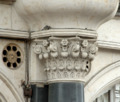The Salisbury
| The Salisbury | |
|---|---|
 The Salisbury, Harringay, looking south east | |
| General information | |
| Address | 1 Grand Parade, Green Lanes Harringay |
| Town or city | London |
| Country | England |
| Coordinates | 51°34′56.2″N 0°05′57.9″W / 51.582278°N 0.099417°W |
| Designations | |
Listed Building – Grade II* | |
| Official name | The Salisbury Public House |
| Designated | 10 May 1974 |
| Reference no. | 1358865 |
The Salisbury is a Grade II* listed pub on Grand Parade in Harringay, North London, England.
History
[edit]| Part of a series on |
| Harringay |
|---|
| History |
| Locations |
| Other |
The Salisbury was designed and built by John Cathles Hill, founder of The London Brick Company. The pub was opened in 1899 with W. A. Cathles, a cousin of Hill, as the manager.[1] Its construction cost of £30,000 is equivalent to approximately £4.27 million as of 2025.[1][2]
It caused something of a stir when it opened, being described by the trade journal, The Licensed Victualler and Catering Trades' Journal in the most glowing terms:
The position it occupies with regard to other "houses" is unique, because of its combination of several distinct establishments. In this it is a paradox, as the hotel, restaurant and public house which it comprises are distinct, but they are nevertheless equally one. The hotel is one of the finest which exists at the present day; it is one also which will take a genius to eclipse.....and the district (in which it was built) has been turned into one of London's finest suburbs.[3]
In 2003, following a period of dilapidation and decline, and temporary closure, it was sympathetically restored and reopened.
In 2008, beer and architecture experts Geoff Brandwood and Jane Jephcote, selected The Salisbury as one of London's top ten heritage pubs in their book, London Heritage Pubs – An Inside Story.[4]
In 2023, The Salisbury came ninth in Time Out magazine's list of Top 50 Pubs In London.[5]
Architectural details
[edit]The exterior is classified as French Renaissance style with shaped gables, ogee domed cupolas and large pedimented dormers. It is constructed of red brick with stone bands and dressings. Its slated mansard roof has a high central tower topped with a wrought-iron crown. The pub has three stories and attic. Polished black larvikite Corinthian pilasters support the fascia. The entrances have ornate wrought-iron screens above imposts, with elaborately tiled lobbies and mosaic floors.
The pub's interior was described by the architectural historian Mark Girouard as a magnificently elaborate and complete interior.[6]
On the first floor there is a large room at the front which was in the past used as a restaurant and concert room. It has an elaborate, compartmented ceiling with ornate fibrous plasterwork, all by the Mural Decoration Company. There is also notable engraved glass by Cakebread Robey in the doors separating off the residential part of the building.[6] This floor was previously used as a church,[7] but has recently been renovated into an expansive luxury apartment.[8]
The bar area has a compartmented ceiling with cast-iron columns. There is a large, curved wooden bar with a stone trough at its base. The bar forms a complete rectangle serving all parts of the large space. The saloon and public bars are divided by a wooden, arched screen containing glass engraved with Art Nouveau motifs. At the rear is the former billiard room, now a function room and kitchen, with top-lit roof glass painted with a creeping vine motif. There are many elaborate engraved mirrors, some stained-glass windows and fire surrounds.[6]
Gallery
[edit]- Architectural detail on the Salisbury
-
Ironwork crown
-
South west tower
-
Decorative iron fretwork above south west entrance
In film
[edit]The level of original detailing in the pub has led to the interior being chosen as a location for a number of films:
- Chaplin, 1992, director Richard Attenborough
- The Long Good Friday, 1980, director John Mackenzie
- Spider, 2002, director David Cronenberg
See also
[edit]References
[edit]- ^ a b Schwitzer, Joan (2002). A London Developer: John Cathles Hill, 1857–1915, Hornsey Historical Society Bulletin, 40. Hornsey Historical Society.(ISSN 0955-8071)
- ^ UK Retail Price Index inflation figures are based on data from Clark, Gregory (2017). "The Annual RPI and Average Earnings for Britain, 1209 to Present (New Series)". MeasuringWorth. Retrieved 7 May 2024.
- ^ 'The Licensed Victualler and Catering Trades' Journal, July 26, 1899
- ^ Brandwood & Jephcote, Geoff & Jane (July 2008). London Heritage Pubs – An Inside Story. CAMRA (Campaign For Real Ale) Books. ISBN 978-1-85249-247-2.
- ^ "The 50 best pubs in London in 2023". Time Out London. Retrieved 1 April 2023.
- ^ a b c Girourad, Mark (1984). Victorian Pubs. Yale University Press. ISBN 978-0300032017.
- ^ Alive Chapel International
- ^ YouTube video of the little seen first floor of The Salisbury
External links
[edit]- CAMRA North London – Salisbury profile
- BBC – Salisbury profile
- Harringay online – website for Harringay residents awarded a Special Judges' Commendation at the Catalyst Awards 2008.
- YouTube video of the little seen first floor of The Salisbury
- Pubs in the London Borough of Haringey
- Grade II* listed buildings in the London Borough of Haringey
- National Inventory Pubs
- Tourist attractions in the London Borough of Haringey
- Commercial buildings completed in 1899
- Grade II* listed pubs in London
- 1899 establishments in England
- Buildings by John Cathles Hill
- Harringay
- 19th-century architecture in the United Kingdom






